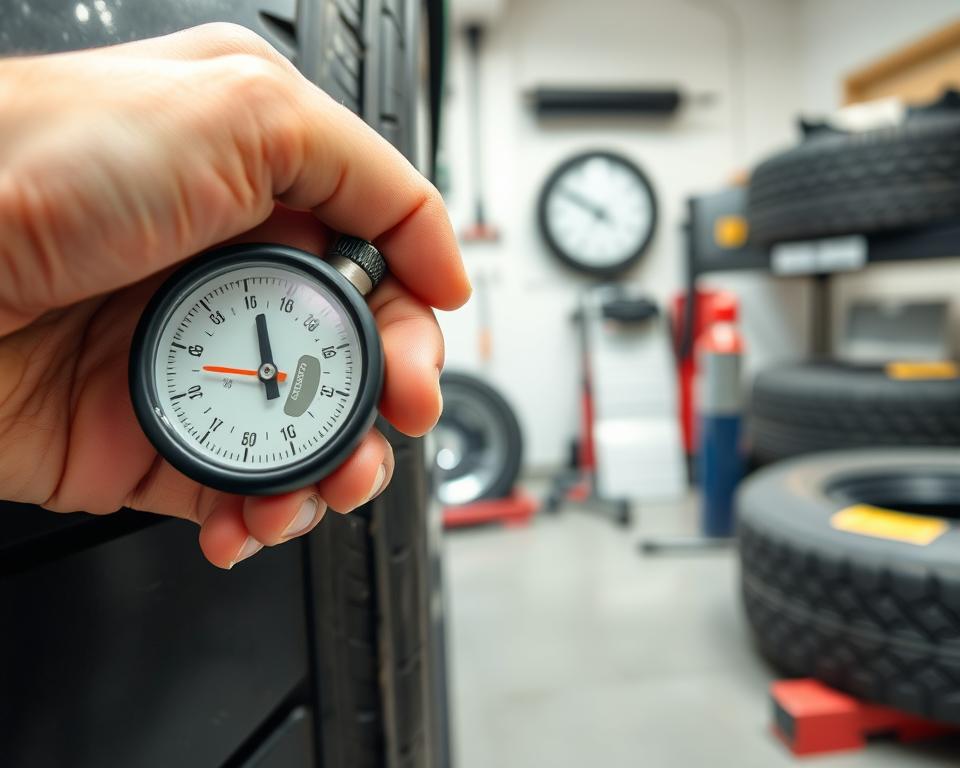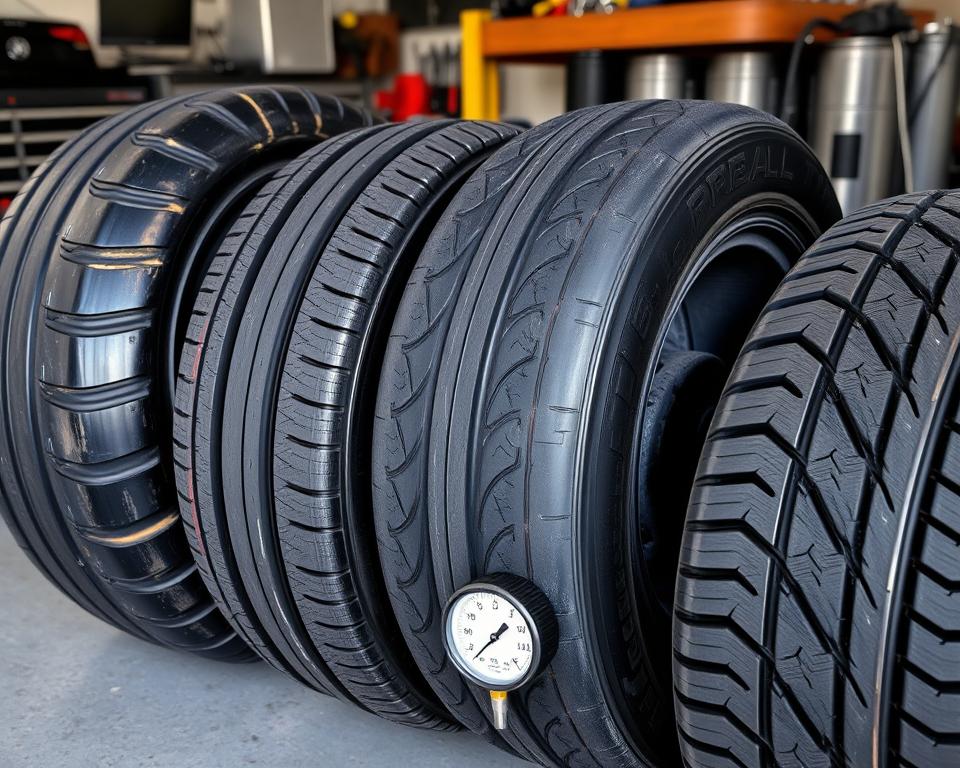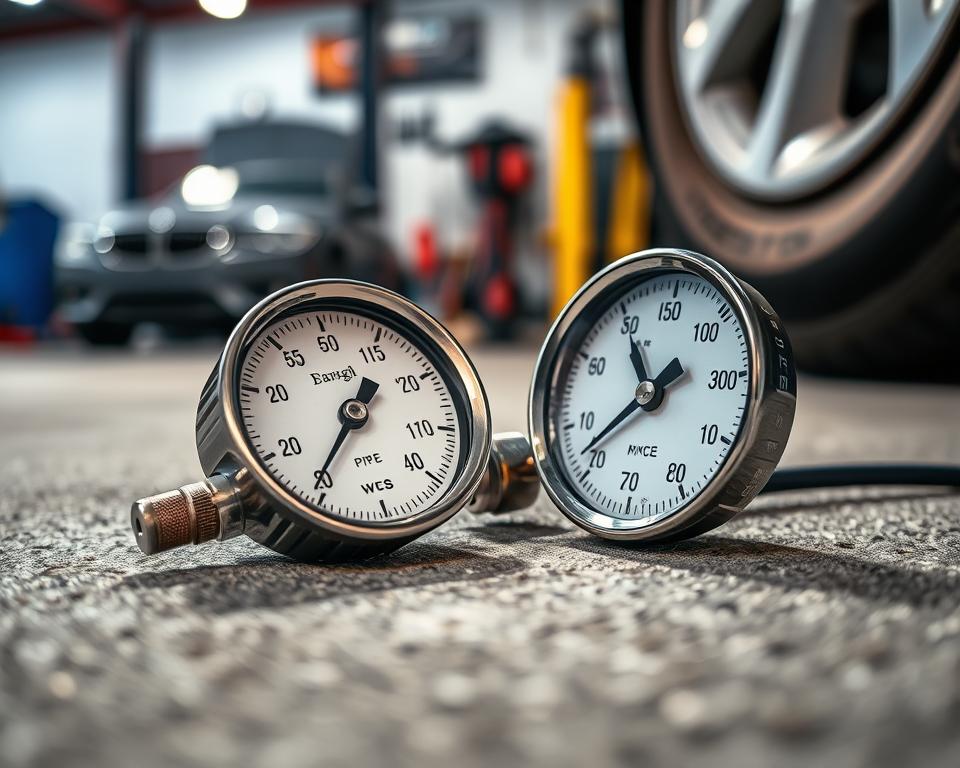Keeping your tires at the right pressure is key for your car’s performance, safety, and how much fuel it uses. An accurate tire pressure gauge is a must-have for checking and keeping your tire pressure just right. This article will dive into why proper tire pressure matters, the types of gauges out there, and what to look for when picking one. We’ll also cover how to use it to get the best results.
Read interesting things at : warlockgroup
Key Takeaways
- Proper tire pressure is essential for vehicle performance, safety, and fuel efficiency.
- Tire pressure gauges come in digital and analog varieties, each with their own pros and cons.
- Factors to consider when choosing a tire pressure gauge include accuracy, precision, durability, and ease of use.
- Regularly checking and maintaining tire pressure can help extend the life of your tires and improve your driving experience.
- Tire pressure monitoring systems (TPMS) can provide additional assistance in monitoring tire pressure.
Importance of Proper Tire Pressure
Keeping the right tire pressure is key for your car’s performance, safety, and how much fuel it uses. If tires are too low, your car handles poorly, brakes longer, and wears out faster. On the other hand, tires that are too high make your ride rough and wear out quicker. The right pressure also helps your car use less fuel by reducing resistance and making it more efficient.
Impact on Vehicle Performance
Having the right tire pressure is vital for your car’s best performance. If tires are too low, steering feels slow, cornering is tough, and your car is less stable. This can be dangerous for you and your passengers. But, if tires are too high, your car rides harshly and has less grip, making it harder to control and less safe.
Fuel Efficiency and Tire Wear
The tire pressure in your car also affects its fuel efficiency and tire wear. Low tires make your car work harder, using more fuel to go the same speed. This costs you more money and makes your tires wear out faster, needing to be replaced sooner.
“Maintaining the correct tire pressure is one of the easiest and most effective ways to improve your vehicle’s performance, safety, and fuel efficiency.”
Types of Tire Pressure Gauges
Having the right tools is key for checking and maintaining tire pressure. There are many types of tire pressure gauges, each with its own features. Knowing the differences can help you pick the best one for your car.
Pencil-Style Tire Pressure Gauges
Pencil-style gauges are a favorite for simple checks. They are small, easy to carry, and show the pressure on a dial or screen. You can keep them in your glove box or tool kit.
Chuck-Style Tire Pressure Gauges
Chuck-style gauges attach directly to the tire valve. They give a more precise reading and often have extra features like an air compressor. These are great for professionals or anyone who checks tire pressure often.
| Gauge Type | Key Features | Typical Use |
|---|---|---|
| Pencil-Style | Compact, handheld design, dial or digital display | Basic tire pressure checks, on-the-go use |
| Chuck-Style | Connects directly to valve stem, larger display, additional features (e.g., air compressor) | Frequent tire pressure monitoring and adjustment, professional use |
It’s crucial to pick a tire pressure gauge that’s accurate, durable, and simple to use. The right tool ensures your tires are at the right pressure. This boosts your car’s performance, saves fuel, and keeps you safe.
Digital vs. Analog Tire Pressure Gauges
Both digital and analog tire pressure gauges have their own benefits and drawbacks. Knowing what each offers can help you pick the best one for you.
Pros and Cons of Digital Tire Pressure Gauges
- Precise Readings: Digital gauges give more accurate tire pressure readings than analog ones.
- Wider Pressure Range: They can measure a wider range of pressures, fitting more vehicles.
- Additional Features: Some digital gauges have backlit displays, unit conversion, and data storage.
- Ease of Use: They’re easier to read, especially in the dark.
- Battery Dependency: They need batteries, which can be a problem if they run out.
- Potential for Inaccuracy: Digital gauges might be less accurate in changing temperatures.
Pros and Cons of Analog Tire Pressure Gauges
- Rugged Construction: Analog gauges are more durable and can handle rough use better.
- Affordability: They’re cheaper than digital gauges, making them a budget-friendly choice.
- Ease of Use: Analog gauges are simpler to use since they don’t need batteries.
- Potential for Inaccuracy: They might not be as precise, especially at high pressures.
- Limited Features: They usually lack extra features like backlit displays or unit conversion.
When deciding between digital and analog gauges, think about your needs. Consider how precise you need the readings, your budget, and the features you want. Both types can help you keep your tires at the right pressure for better vehicle performance.
Factors to Consider When Choosing a Tire Pressure Gauge
When picking a tire pressure gauge, several important factors come into play. You need to think about accuracy, durability, and how easy it is to use. These factors can greatly affect your vehicle’s tire performance and safety.
Accuracy and Precision
An accurate tire pressure gauge is key for getting reliable readings. The more precise it is, the better it can spot small changes in pressure. This accuracy is crucial for keeping your tires at the right pressure, which improves your car’s performance and fuel efficiency.
Durability and Ease of Use
Tire pressure gauges face many challenges, like weather and drops. A durable, well-made gauge is a must. Also, a large, clear display and simple design make checking tire pressure easier and faster.
| Factors | Importance |
|---|---|
| Accuracy and Precision | Critical for reliable tire pressure readings and optimal vehicle performance |
| Durability and Ease of Use | Essential for a gauge that can withstand daily use and provide a hassle-free experience |
By carefully considering these key factors when choosing a tire pressure gauge, you can ensure your vehicle’s tires are properly inflated. This improves safety, fuel efficiency, and your overall driving experience.
Top-Rated Tire Pressure Gauges
Keeping your tires at the right pressure is key. A good tire pressure gauge is a must-have. The market has many top choices, each offering accurate and easy-to-use readings. Whether you like digital or analog, these gauges ensure your tires are always in top shape.
The Tire Pressure Gauge by Accutire is a top pick. It has a big, clear display and measures 5-150 PSI. This makes it perfect for many car tires. It’s also accurate to ±1 PSI, helping you keep your tires at the right pressure.
If you prefer something simpler, try the Milton S-921 Dial Tire Gauge. It’s made of stainless steel and is easy to use. Its big dial and sturdy build make it great for anyone who loves cars or works on them.
- Accutire Digital Tire Pressure Gauge
- Milton S-921 Dial Tire Gauge
- Tekton 5941 Digital Tire Gauge
- Longacre 52-50009 Digital Tire Pressure Gauge
- Topline Automotive Engineering Tire Pressure Gauge
When picking a tire pressure gauge, think about accuracy, durability, and how easy it is to use. These high-quality tools help keep your tires in great shape. They improve your car’s performance and make your tires last longer.
How to Use a Tire Pressure Gauge Correctly
Checking your vehicle’s tire pressure is key for better performance, fuel use, and tire life. By following a simple guide, you can get accurate readings from your tire pressure gauge. This helps you make the right changes. Here’s how to use a tire pressure gauge correctly.
Step-by-Step Guide
- Find the tire valve stem: It’s the metal part sticking out from the wheel, where you attach the gauge.
- Take off the valve stem cap: Remove the cap to show the valve stem and get ready for the gauge.
- Securely attach the gauge to the valve stem: Press the gauge firmly onto the valve stem for a tight fit.
- Look at the pressure reading: See the gauge’s numbers to find out the current tire pressure.
- Change the tire pressure if needed: If it’s not right, use air to add or a valve tool to take away air.
By following these easy steps, you can learn how to use a tire pressure gauge right. Regular checks and adjustments can really improve your vehicle’s performance and fuel use.

“Proper tire inflation is essential for optimizing your vehicle’s performance and extending the life of your tires.”
Always check the tire pressure your car maker suggests. You can find this in the owner’s manual or on a sticker on the driver’s side door jamb. Keeping the right tire pressure will make your car run better and keep you safe and comfortable while driving.
Maintaining and Calibrating Your Tire Pressure Gauge
It’s key to keep your tire pressure gauge accurate for the best tire inflation. This boosts your car’s performance. Regularly maintain and calibrate your automotive tools to ensure they work well.
- Regular Cleaning: Clean your tire pressure gauge with a dry cloth to remove dirt and moisture. This keeps it working right.
- Proper Storage: Store your gauge in a cool, dry spot when not using it. This protects it from damage caused by weather.
- Periodic Calibration: Your gauge might lose accuracy over time. Check it often against a certified gauge to keep it precise.
By following these steps, your tire pressure gauge will always give you accurate readings. This helps you keep your tires at the right pressure. It also improves your car’s performance, fuel use, and tire life.
“Properly maintaining and calibrating your tire pressure gauge is crucial for ensuring accurate measurements and optimizing your vehicle’s performance.”
Tire Pressure Monitoring Systems (TPMS)
Many modern vehicles have advanced Tire Pressure Monitoring Systems (TPMS). This is a key safety feature that helps keep tires at the right pressure. It uses sensors to check each tire’s air pressure and alerts you if it’s off.
Understanding TPMS Technology
TPMS is important for your car’s performance and safety. It keeps tires inflated right, which saves fuel and improves handling. If it spots a pressure change, it tells you right away.
The main parts of a TPMS system are:
- Tire pressure sensors: These are in each wheel and check the air pressure constantly.
- Control unit: It gets the sensor data and checks if the pressure is okay.
- Warning lights: If the pressure is too low, a light on the dashboard tells you.
Using TPMS helps keep tires in good shape. It makes driving safer, more efficient, and better for your car.
| TPMS Technology | Benefits |
|---|---|
| Continuous Tire Pressure Monitoring | Ensures optimal tire inflation for improved safety, performance, and fuel efficiency |
| Real-Time Pressure Alerts | Notifies drivers of any significant changes in tire pressure, allowing for prompt action |
| Compatibility with Modern Vehicles | Widely available as a standard feature in many new car models |
Knowing how tire pressure monitoring systems work helps drivers use this vehicle safety equipment well. It keeps tires in top shape, making driving better.
Common Tire Pressure Problems and Solutions
Keeping your tire pressure right is key for your car’s performance, safety, and gas use. But, many things can make your tires too full or too empty. This can lead to a bunch of problems. From slow leaks to changes in temperature, keeping an eye on your tire pressure is hard.
Underinflated tires are a big issue. They make your car use more gas, wear out your tires faster, and handle poorly. The fix is easy: just check your tire pressure often and fill them up to the right level.
Overinflated tires are a problem too. They make your car ride rough, wear out your tires too soon, and lose grip. To fix this, watch your tire inflation closely and adjust it when needed.
Slow leaks can be sneaky, as they might not show up right away. Always check your tires for any holes or damage. Fix any leaks fast to keep your tire pressure just right.
By being careful and taking action early, you can keep your tires at the best tire pressure. This will make your car run better, be safer, and use less gas.

“Proper tire pressure is the foundation of a well-performing vehicle. Neglecting it can lead to a host of issues that impact both your driving experience and the longevity of your tires.”
The Importance of Regular Tire Pressure Checks
Regular tire pressure checks are key for vehicle maintenance. Experts say to check your tire inflation monthly or before long trips. This habit helps spot and fix problems early, avoiding bigger issues later.
Keeping tires at the right pressure is vital for safety, performance, and fuel use. Underinflated tires wear unevenly, handle poorly, and may blow out. Overinflated ones lose traction and make stopping harder.
- Regular tire pressure checks ensure your vehicle runs smoothly.
- Correct tire inflation boosts fuel efficiency and tire life.
- Ignoring regular tire pressure checks can cause expensive vehicle maintenance problems.
By regularly checking and maintaining tire pressure, you get a safer, more efficient, and longer-lasting drive. A few minutes on this task can greatly benefit your vehicle’s condition.
“Proper tire inflation is one of the most important, yet often overlooked, aspects of vehicle maintenance.”
Tire Pressure Gauge: Measure with Precision
A reliable tire pressure gauge is key for any car owner. It helps you check your tire air pressure accurately. This ensures your tires are inflated right, improving your car’s performance and tire life. Whether you like digital or analog gauges, a good one gives you peace of mind.
It’s important to measure tire pressure correctly. Under-inflated tires waste fuel, wear unevenly, and can blow out. Over-inflated ones are rough and lose traction. A tire pressure gauge lets you check each tire easily, keeping them at the right pressure.
When picking a tire pressure gauge, think about its accuracy, durability, and how easy it is to use. Digital ones are precise, but analog ones are tough and good for rough places. Choose what fits your needs best.
| Feature | Digital Tire Pressure Gauge | Analog Tire Pressure Gauge |
|---|---|---|
| Accuracy | High | Moderate |
| Durability | Moderate | High |
| Ease of Use | High | Moderate |
It doesn’t matter if you pick a digital or analog tire pressure gauge. Keeping it maintained and calibrated is key for accurate readings. Regular checks and calibrations ensure your gauge works well, giving you confidence in your tire health.
“Properly inflated tires can improve your vehicle’s fuel efficiency, handling, and overall safety on the road.”
By getting a quality tire pressure gauge and checking your tires often, you’re taking care of your car. With the right tools and knowledge, you can drive safely and efficiently.
Conclusion
Keeping the right tire pressure is key for your car’s safety, performance, and gas use. A good tire pressure gauge is a must-have. It helps you get your tires just right and keeps your car running smoothly.
The Acme Digital Tire Pressure Gauge and the Kobalt Analog Tire Pressure Gauge are great choices. They give accurate readings, last long, and are easy to use. No matter if you pick digital or analog, checking tire pressure often and keeping your gauge in good shape is important.
Buying a quality tire pressure gauge and making it part of your car care routine is smart. It makes your tires last longer, saves gas, and makes your car safer and easier to handle. Remember, proper tire pressure is crucial. Use a reliable gauge to keep your car in top shape.
